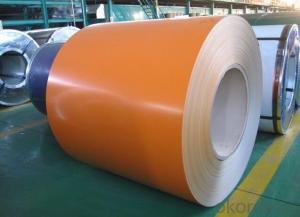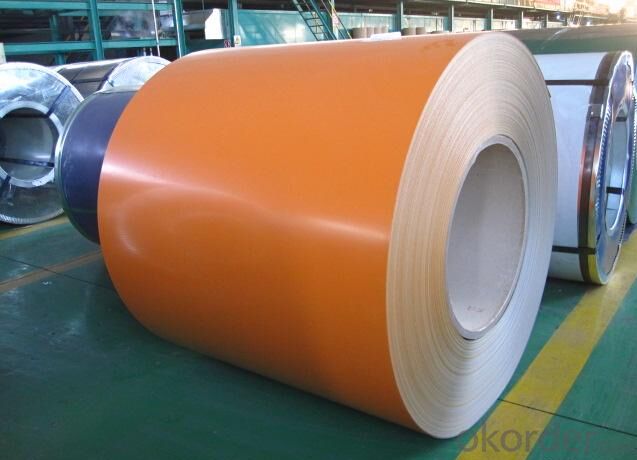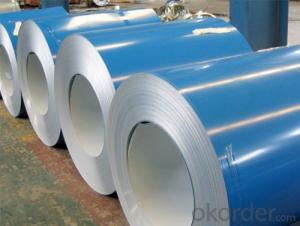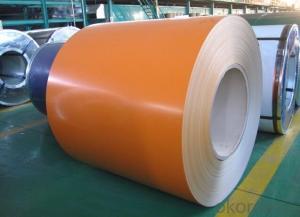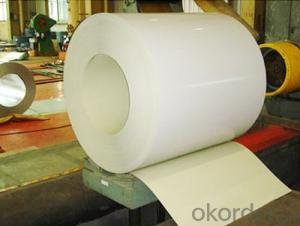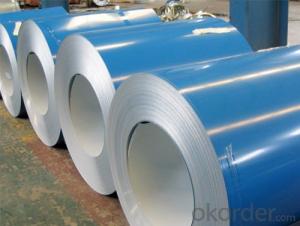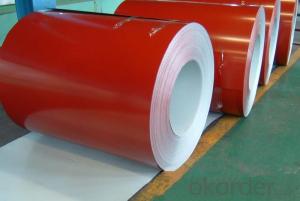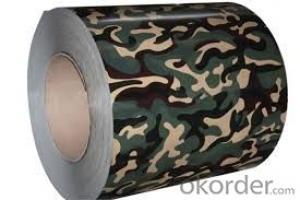Pre-painted Galvanized Sheet Coil with Good Quality and Lowest Price
- Loading Port:
- Shanghai
- Payment Terms:
- TT OR LC
- Min Order Qty:
- 100 m.t.
- Supply Capability:
- 10000 m.t./month
OKorder Service Pledge
OKorder Financial Service
You Might Also Like
1.Structure of Pre-painted Galvanized/Aluzinc Steel Coil Description
finally the plate steel is called pre-painted galvanized (aluzinc) steel. Pre-painted galvanized steel is good capable of decoration, molding, corrosion resistance. 2.Main Features of the Pre-painted Galvanized/Aluzinc Steel Coil
• Excellent corrosion resistance
• Excellent weather resistance
• Capability of decoration, molding, corrosion resistance
• Excellent heat resistance performance
• High strength
3.Pre-painted Galvanized/Aluzinc Steel Coil Images
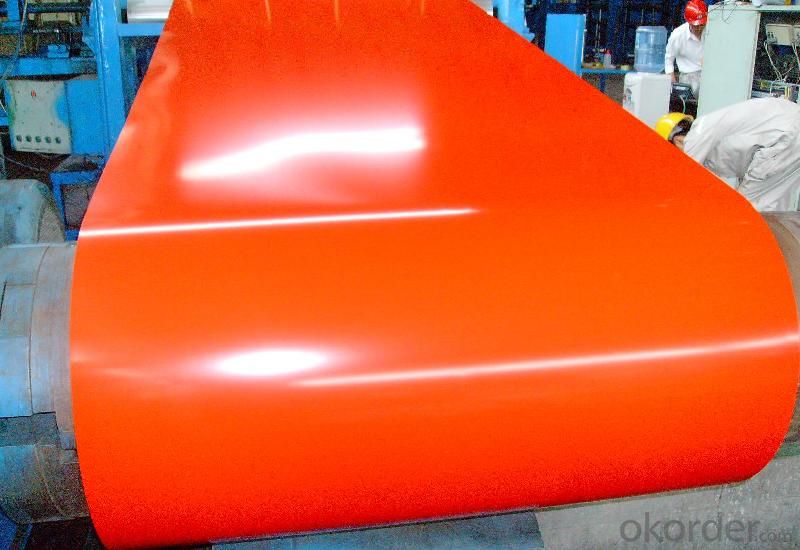
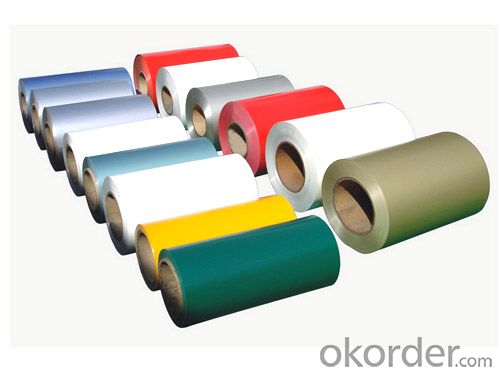
4.Pre-painted Galvanized/Aluzinc Steel Coil Specification
Quality standar: JIS G3312 CGCC & CGLCC
Hardness of P: Both soft and hard quality are available
Surface finish: with or without protect film
Thickness : 0.14-1.20 mm
Width : 914mm, 1000mm, 1220mm and 1250mm, thickness 600-1250mm is available
Max loading weight in one 20ft container : 25 tons generally
Finish by coil or sheet: Both sheet and coil are available
8Zinc coating: 60-275G/M2, both sides
Paint thickness for top side : 5 micron primer + (10-20) microns modified polyester, any RAL color code.
Paint thickness for back side: (5-10) microns Epoxy
Weight per coil: 4-6 tons, also can be upon customer's requirements
5. FAQ of Pre-painted Galvanized/Aluzinc Steel Coil
We have organized several common questions for our clients,
We have established the international advanced quality management system,every link from raw material to final product we have strict quality test;
- Q: Can steel coils be coated with luminescent materials?
- Yes, steel coils can be coated with luminescent materials. This process involves applying a layer of luminescent material onto the surface of the steel coils, allowing them to emit light in the dark or under specific lighting conditions.
- Q: What is the weight range of steel coils?
- The weight range of steel coils varies depending on the specific type and dimensions, but they generally range from a few hundred kilograms to several tonnes.
- Q: Can steel coils be deep-drawn?
- Yes, steel coils can be deep-drawn. Deep drawing is a metal forming process in which a sheet or coil of material, such as steel, is stretched and pulled into a die to create a deep, hollow shape. Steel coils are often used in industries such as automotive, appliance, and manufacturing, where deep-drawn components are required for various applications.
- Q: Iron melts faster when there will be low carbon in Iron.During steel making the molten Iron gets purified and alloying being done through the process. How the carbon is being controlled at Iron melting stage and what it is called?
- It's not really that hard. You can use your charcoal grill to do it. First build a large fire in it and then bury the steel in the coals. It'll only take about ten minuites or so for the steel to heat through. Then pick it out of the coals with tongs and drop it into a bucket of water. Repeat as desired. Eventually it'll get as brittle as glass. To fix this, you must anneal the metal. Again heat the metal in the coals, only this time let it stay there until the coals go all the way out all by themselves. Next day when all the way cool, Take it out and clean it off. Viola!, you have hardened steel.
- Q: What are the different methods of corrosion protection for steel coils?
- Steel coils can be protected from corrosion using several different methods, each with its own advantages and disadvantages. One commonly used method is to apply a protective coating to the steel coils. This can be done through various techniques like hot-dip galvanizing, electroplating, or painting. Coatings act as a barrier between the steel surface and the corrosive environment, preventing direct contact and reducing the risk of corrosion. Another option is the use of VCI materials, which release chemicals that inhibit corrosion when they come into contact with the steel surface. These materials can be applied as coatings, films, or papers, and are particularly useful for long-term storage or shipping of steel coils. Cathodic protection is a method that involves the use of sacrificial anodes or impressed currents. Sacrificial anodes, made of zinc or aluminum, are connected to the steel surface and corrode instead of the steel, sacrificing themselves to protect the coils. Impressed current systems use a direct electrical current to prevent corrosion on the steel surface. Proper wrapping and packaging can also provide corrosion protection for steel coils. This includes using moisture barrier films, desiccants, or absorbent materials to reduce moisture content. Adequate ventilation and avoiding contact with other corrosive substances are also important. Controlling the environment in which the steel coils are stored or used is crucial for corrosion protection. This involves maintaining proper humidity levels, controlling temperature, and managing air quality. By minimizing exposure to corrosive elements like moisture, salts, or chemicals, the risk of corrosion can be significantly reduced. It's worth noting that the choice of corrosion protection method depends on factors such as the specific application, budget constraints, and desired lifespan of the steel coils. A combination of these methods may also be used to enhance corrosion protection.
- Q: Is steel cut really better? The nutritional profiles are nealy identical. Which one has the best flavor??Thanks!
- Steel cut oats taste the best but rolled oats will do just fine too.
- Q: How are steel coils used in the production of metal ceilings?
- Steel coils play a vital role in the manufacturing of metal ceilings. Typically composed of high-quality steel, these coils serve as the fundamental material for fabricating metal ceiling panels. To commence the process, the steel coils are uncoiled and fed into a roll forming machine. Gradually, this machine shapes the steel into the desired profile for the ceiling panels. The coils pass through a series of rollers that bend and mold the steel into the necessary dimensions and design. Once the steel has taken its desired shape, it is cut into individual panels of the required length. These panels then undergo various finishing processes, including surface treatment, painting, or powder coating, to enhance their appearance and durability. Steel coils are the preferred choice for producing metal ceilings due to their exceptional strength and rigidity. They establish a robust foundation for the ceiling panels, ensuring their longevity and resistance to deformation. Additionally, steel coils offer superior fire resistance, making them a safe option for commercial and industrial buildings. Apart from their structural advantages, steel coils also allow for a wide array of design possibilities. The malleability of steel enables manufacturers to create intricate patterns and textures on the surface of the ceiling panels, adding aesthetic appeal and enhancing the overall interior design. In summary, steel coils are an essential component in the production process of metal ceilings. They possess the necessary strength, durability, and versatility for crafting high-quality and visually pleasing ceiling panels utilized in various commercial and residential settings.
- Q: How are steel coils cleaned?
- Steel coils are typically cleaned using a combination of mechanical and chemical methods. First, the coils are subjected to high-pressure water jets to remove any loose dirt, dust, or debris. Then, a specialized cleaning solution or detergent is applied to dissolve and remove any oil, grease, or stubborn stains. The coils are rinsed thoroughly to ensure the removal of all cleaning agents, followed by drying to prevent corrosion.
- Q: Explain why a steel nail sinks but a steel ship floats.
- surface area of the ship against the water is much greater than the nail.
- Q: Ive been playing with my ping i3 graphite irons for 6 years now and some days i can hit it and some days i cant. Then i tried out my friends irons the other day and he had steel and i was hitting the ball anywhere i wanted it to go..Is that a fluke or is steel irons just better than shaft? I was thinking about trading my graphites for steel, is that a good idea??
- Graphite is a lot lighter and will allow you to generate more swing speed and probably greater distance. I hit my graphite clubs about one club longer than my steel shafts. But, my steel shafts are far more accurate. I find I hit a lot more greens in regulation using my steel shafted irons than I do with my graphites. Since accuracy is far more important than distance for most people, I choose the steel shafted irons most of the time. You will NEVER see a professional or a low handicapper using graphite irons for this reason.
Send your message to us
Pre-painted Galvanized Sheet Coil with Good Quality and Lowest Price
- Loading Port:
- Shanghai
- Payment Terms:
- TT OR LC
- Min Order Qty:
- 100 m.t.
- Supply Capability:
- 10000 m.t./month
OKorder Service Pledge
OKorder Financial Service
Similar products
Hot products
Hot Searches
Related keywords
